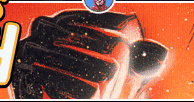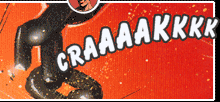   |
  |
WHO'S GUARDING US NOW?: HEROES FOR THE NEW MILLENNIUMWith most of the comic book heroes of the forties, seventies, and eighties no longer in evidence, and with even our comic-art satirists turning away from the depiction of figures like Captain Canada, it might appear that the Canadian national-superhero tradition is in decline – that we might actually become (Shudder!) a country without costumed guardians such as Fleur de Lys or Johnny Canuck. Reinforcing this perception is the fact that most of Canada's finest superhero artists – including John Byrne, George Freeman, Todd McFarlane, Tom Grummett, Gabriel Morrissette, Dale Keown, Ken Steacy, Denis Rodier, Dave Ross, Ty Templeton, and Stuart Immomen – work primarily on American comics. The reality, however, is that the dream of a national superhero is likely to persist as long as Canadians produce comic art. Superheroes and comic books now seem inextricably linked, and as long as there are superheroes, some of them will inevitably serve to personify our ideals, including our national aspirations. The national heroes that have fallen by the wayside were mostly victims of economics; as new Canadian comics firms emerge, so will new superheroes. And while Canadians are probably too wary of the uncritical portrayal of heroism for superheroes ever to become the mainstay of our indigenous comic art (our real forte, in both English and French Canada, is satire and humour), it is obvious that the genre in general and the national-superhero sub-genre in particular have been and will remain a fascinating part of the Canadian comic-art tradition. The fact that none of our national superheroes has yet achieved the status and acceptance within Canada of icons such as Superman or Batman (although, as a result of the 1995 Superheroes stamp issue and Richard Comely's promotional skills, Captain Canuck has achieved a significant degree of recognition), will not discourage our comic artists from continuing to delineate their visions – be they heroic or satirical – of the ultimate Canadian superhero. For there is an unmistakable appeal in such characters, and most of those who have endeavoured to provide the country with its own heroes would probably identify with Adrian Dingle's summation of his work on Nelvana, our first national superhero: "Some say, well, it's a bit of Canadiana, and that's possibly true. We loved doing it, that was the primary thing."(8) Not only can we expect a third generation of national superheroes, it is also inevitable that at least some of the earlier heroes will be resurrected. So if Canada finds itself at this time without a widely recognized national guardian, it is likely a situation that will be shortlived. Consequently, serious students of our popular culture are well advised to keep an eye on the sky. Somewhere up there, today or tomorrow – or someday after tomorrow – what at first appears to be a bird or a plane will instead turn out to be a costumed superhero, a national guardian bent on protecting the True North Strong and Free. (It might also be advisable to keep an eye on the street, since not all our guardians can fly.) Such a sighting might mark the return of Nelvana or Captain Canuck or Capitaine Kébec or the arrival of a colourful new "bit of Canadiana," some new embodiment of our national spirit and identity. Obviously, we need heroes, including our own costumed Guardians of the North. And we also need to celebrate these figures and make them a permanent part of our popular culture, because if we forget our heroes, we ultimately lose part of ourselves. "Beavers Up!" – John Bell
NOTES1. See McLuhan's essay "Superman" in The Mechanical Bride; Folklore of Industrial Man, New York, NY: Vanguard Press, 1951, p. 103. 2. See Dave Sim's "A Conversation with Adrian and Pat Dingle and Bill Thomas" in Now and Then Times Vol. 1, No. 2 (Oct. 1973), pp. 28-29. 3. See the interview with Dingle cited above, p. 29. 4. For an interesting study of the post-war period in U.S. comics see William Savage Jr.'s Comic Books and America, 1945-1954, Norman, OK: University of Oklahoma Press, 1990. 5. See La Barre du Jour Nos. 46-49 (Winter 1973), a book-length special issue on Quebec comics edited by André Carpentier. 6. See Larry Mitchell's "John L. Byrne Looks at the New Canadian Comics" in The Melting Pot No. 5 (Winter 1972-73), pp. 7-9. 7. Captain Canada appeared in The Journal Summer Special (1974); Capitaine Québec and Langlais, in Québec Humour No. 1 (Jan.-Mar. 1978); and Captain Canduck, in Orion No. 2 (1982). 8. See the interview with Dingle cited above, p. 29. |